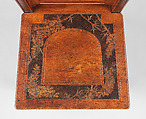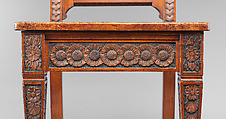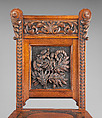Chair
Possibly made by John Mowat (1840-1917)
Not on view
This chair exemplifies the bold, expressive carving traditions that took hold in Cincinnati, Ohio during the 1870s and 1880s. It resembles the work of Henry Fry (1807-1895), one of the leading practitioners of what came to be known as Cincinnati "art carving." In the 1850s, three English emigrees, Henry Fry, William Fry (1830-1929), and Benn Pitman (1822-1910), arrived in Cincinnati and found a receptive audience for their work. By the mid-1870s, they were leading a group of mostly female artisans who attracted widespread attention for their virtuosic and dynamic carving. The Frys and Pitman taught woodcarving to hundreds of students, contributing to Cincinnati becoming an important artistic center during the late nineteenth and early twentieth centuries. Cincinnati art carved furniture manifests a distinctive expression of the Aesthetic Movement. This chair combines a range of carving styles, incorporating rough, angular, abstracted carving together with highly finished and refined carved elements. Although it is not known who made the chair, it could have been produced by any number of carvers who studied or worked with Fry. One possibility is the Scottish-born carver John Mowat (1840-1917), who worked as a carver and superintendent of various furniture firms in New York City, Boston, Detroit, Grand Rapids, and Cincinnati. In the hall or reception room in which it was displayed, this chair would have signaled the sophistication and progressive artistic sensibilities of its owner.
Due to rights restrictions, this image cannot be enlarged, viewed at full screen, or downloaded.
This artwork is meant to be viewed from right to left. Scroll left to view more.






